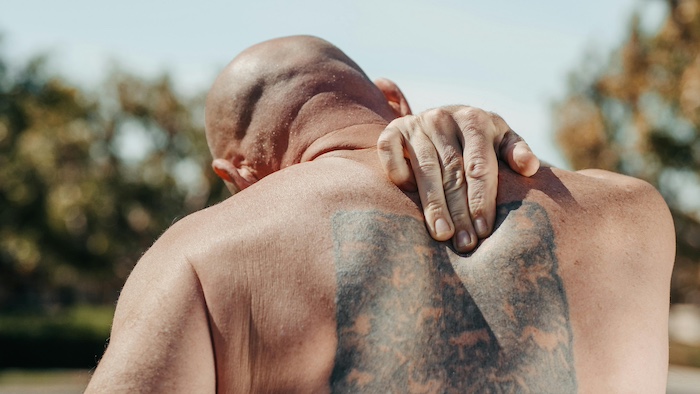
Upper back pain symptoms can differ from person to person. For some, the pain might be mild and go away within a couple of days, but for others, the pain can worsen and interfere with daily tasks. Upper back pain symptoms and treatment plans can vary greatly depending on the problem’s underlying cause.
Common Upper Back Pain Symptoms
Upper back pain can feel like one or more of the following:
- Sharp pain. This pain is typically described as excruciating and can feel knife-like, burning, or as if being gripped in a vice. It is usually located in one spot instead of spreading across a region.
- General discomfort. An achy or throbbing pain may be felt in part of the upper back, and it could potentially spread into a nearby area, such as the neck, shoulder, or lower back.
- Stiffness. If either sharp pain or general soreness becomes bad enough, it can contribute to reduced mobility of the upper back’s muscles, ligaments, and/or joints. While reduced mobility in the upper back is typically not significant because that area of the spine is built more for rigidity than motion, it could make certain arm movements, such as rotation or lifting, more difficult or even impossible.
- Radiating pain. This pain can travel along a nerve from the thoracic spine and potentially go into the arm, chest, stomach, or further down the body. Radiating pain can range from dull to sharp or electric shock-like, and it may come and go or be continuous. It is usually only felt on one side of the body, such as going into the chest on one side.
- Tingling, numbness, or weakness. Just like radiating pain, these symptoms can also radiate along a nerve from the thoracic spine and are into the arm, chest, stomach, or lower in the body. Pins-and-needles tingling or numbness radiating from the thoracic spine can feel like the shape of a band running along one of the ribs.
If upper back pain becomes bad enough, it can affect normal activities, such as the ability to lift moderately heavy objects, throw a ball, or even comfortably sit or rest.
Onset of Upper Back Pain Symptoms
Upper back pain symptoms could start in any number of ways, including:
- Sudden. Pain could begin immediately after an injury or out of the blue for no apparent reason at all.
- Delayed. Sometimes pain from an injury takes a few hours or longer before it shows up. The reason for this is not always known, but it could be due to an inflammatory process or how pain might be felt in another area of the body before it is noticed in the upper back.
- Gradual. Pain may start mild and slowly worsen over time.
Sometimes upper back pain comes and goes. Intermittent pain may or may not become worse over time, depending on the cause. Pain could feel worse in the morning and get better during the day, or it might be worse in the evening but feel better after rest.
Upper Back Pain Symptoms by Location
At each level of the thoracic spine, two nerve roots (one on each side) branch into networks of nerves that enable sensation and motor functions on that side of the body. If a nerve root becomes compressed or inflamed, such as from a herniated disc, then thoracic radiculopathy symptoms of pain, tingling, numbness, and/or weakness can potentially radiate in different directions depending on the specific vertebral level of the nerve compression: 1
- T1 and T2. If one of these nerve roots at the top of the thoracic spine becomes irritated, symptoms can radiate into the arm or possibly into the chest.
- T3, T4, T5. These nerve roots are likely to radiate symptoms into the chest.
- T6, T7, T8. These nerve roots could radiate symptoms into the chest or down into the abdomen—or both.
- T9, T10, T11, T12. These nerve roots at the bottom of the thoracic spine are more likely to radiate symptoms into the abdomen or lower in the back.
These thoracic radiculopathy symptoms are typically only felt on one side of the body. Also, adjacent vertebral levels can share overlapping nerve wiring, and these overlaps can vary from person to person.
When Upper Back Symptoms Need Medical Attention
If upper back pain is accompanied by any of the following, it should be checked by a doctor immediately:
- Problems with balance or walking
- Difficulty with bladder or bowel control
- Pins-and-needles tingling, weakness, and/or numbness anywhere in the upper back or below, such as in the chest, stomach, buttock, or down the legs
- Trouble breathing
- Fever or chills
- Severe headache
In addition, upper back pain that lasts for weeks and/or interferes with daily tasks, such as going to work or getting a good night’s rest, warrants a visit to the doctor.
Precision Pain Care and Rehabilitation has two convenient locations in Richmond Hill – Queens, and New Hyde Park – Long Island. Call the Queens office at (718) 215-1888 or (516) 419-4480 for the Long Island office to arrange an appointment with our Interventional Pain Management Specialists, Dr. Jeffrey Chacko or Dr. Sonny Ahluwalia.













